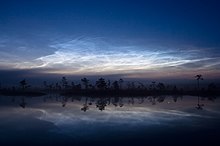Luminous night cloud
Luminous night clouds (abbreviation NLC from noctilucent clouds ) are collections of ice crystals above the mesosphere in the mesopause . There the absolute temperature minimum of the earth's atmosphere is reached. They appear at an altitude of 81 to 85 km - in contrast to the cloud forms of the troposphere , which reach a maximum height of 13 km. These are not to be confused with the polar stratospheric clouds .
Observations
Most sightings in Central Europe there are from early June to late July (ie during the months around the summer solstice ) well after sunset (22-23 hrs CEST) or in the morning in the first dawn (3-4 pm EDT) to see. Luminous night clouds usually appear in the northwest to northeast as luminous fibrous clouds.
On April 26, 2007, the Earth observation satellite Aeronomy of Ice in the Mesosphere (AIM) was launched to investigate the phenomenon of glowing night clouds.
morphology
Due to their great height, the Luminous Night Clouds can also be illuminated by the sun, which is obliquely below the horizon, after sunset or before sunrise, and can thus be made to "shine". They become visible when the sun is between 6 ° and 16 ° below the horizon. The light of the sun is then still reflected by the glowing night clouds, while the sky is otherwise almost already or still dark. Their coloration depends on the position of the sun and can range from yellow to silvery mother-of-pearl.
Emergence
The origin of the crystallization nuclei has not yet been finally clarified. The noctilucent clouds were first in 1885, two years after the eruption of the Krakatau described and interpreted as a consequence of the eruption. However, to the surprise of scientists, they were also observed in the years and decades that followed. Even if aerosols from the Krakatau eruption temporarily contributed to the formation of Luminous Night Clouds, there must consequently be another and permanently available source for crystallization nuclei. Today, the prevailing opinion is that this is material that is released when meteors burn up. In fact, shooting stars typically light up at the exact same altitude as the glowing night clouds. The metal atomic layers also found there are the product of burned-out meteoroids .
Due to the low density, strong atmospheric turbulence and currents occur at times when there are pressure and temperature differences in the mesosphere. They cause a rapid mixing of the gases that rise from the lower atmosphere and transport water vapor from the stratosphere via the mesosphere to the very cold mesopause, where they condense on the existing crystallization nuclei ( e.g. dust particles ).
This rapid air mass transport by convection in the presence of water typically causes an almost adiabatic expansion of the gas mixture, which can result in locally significantly lower temperatures (down to −140 ° C) compared to the temperature of −85 ° C normally prevailing in the mesopause. These spatially limited temperature anomalies are obviously an important prerequisite for the formation of the glowing night clouds in connection with the presence of crystallization nuclei.
gallery
- Luminous night clouds
Luminous night clouds over Saimaa
Glowing night clouds, recorded by the AIM earth observation satellite
Web links
- Glowing night clouds in Germany in time lapse
- Luminous night clouds Description of www.meteoros.de
- Luminous night clouds and their observation in Central Europe
- Photos noctilucent clouds taken from the earth and by means of a NASA satellites ( Engl. )








